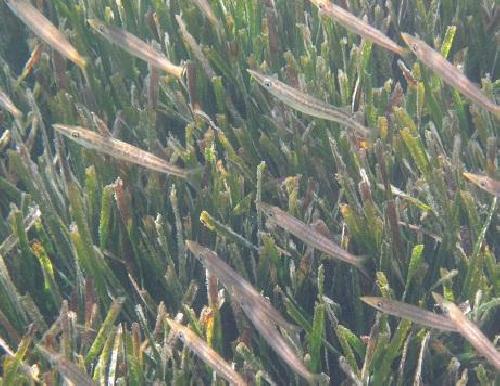Seagrass is the quiet achiever. The bundles of foliage often found washed up on beaches come from one of the most productive members of the plant kingdom. The long, narrow, ribbon-like leaves provide food and shelter for marine animals and mitigate coastal erosion and greenhouse gas emissions by cushioning the impact of sea waves while capturing carbon dioxide from the atmosphere.
Carlos Duarte and colleagues at the KAUST Red Sea Research Center have sequenced and analyzed the genome of Zostera marina, a widespread genus of seagrass found in temperate waters of the northern hemisphere1. Their results show that seagrass ancestors underwent several major evolutionary changes before they migrated from shallow ponds back into deep seas.
The work is significant because the seagrass genome is the first marine flowering plant ever to be sequenced.
 Seagrass provides food and shelter for a wide range of marine organisms, including fish, crabs and turtles. Credit: © 2016 KAUST
Seagrass provides food and shelter for a wide range of marine organisms, including fish, crabs and turtles. Credit: © 2016 KAUST
"It took us more than seven years to disentangle the evolutionary code contained in the genome," said Duarte. The findings have important implications for a range of pressing issues, including food security, climate change and marine conservation.
The researchers obtained a clone of Z. marina from the Archipelago Sea, which is located off the southwestern coast of Finland. They sequenced its genome using a combination of methods and identified 20,450 protein-coding genes, of which 86.6 percent were present in the seagrass leaves, roots and flowers. By comparing the genome of Z. marina with that of its freshwater cousin Spirodela polyrhiza, the researchers concluded that the two genera diverged somewhere between 135 and 107 million years ago.
In addition, they showed that Z. marina ancestors gave up genes that were superfluous in the marine environment--for example, genes for growing stomata (the leaf pores needed for transpiration), making terpenoids (organic compounds responsible for chemical communication, which are only useful if released in the atmosphere), detecting ethylene gas (signaling molecules essential for plant growth) and resisting ultraviolet radiation.
Seagrass instead gained genes that improved tolerance to high salinity and gas and nutrient exchange across the leaves--for example, genes for strengthening cell walls, resisting osmotic stress and improving nutrient uptake in saltwater.
Thanks to these evolutionary innovations, seagrass entered a world free of terrestrial competitors, insect pests, droughts, fires and weather extremities. Perhaps for these very reasons, seagrass thrived along rocky reefs, dominated all coastal waters and conquered the seven seas.
source: King Abdullah University of Science & Technology (KAUST)